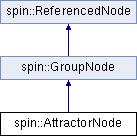A node to attract (or repulse) other nodes. More...
#include <AttractorNode.h>

Public Types | |
| enum | attractorMode { EXTRINSIC, INTRINSIC } |
Public Member Functions | |
| AttractorNode (SceneManager *sceneManager, const char *initID) | |
| virtual void | callbackUpdate (osg::NodeVisitor *nv) |
| void | setDistanceDecay (float decay) |
| float | getDistanceDecay () const |
| void | setAngularDecay (float decay) |
| float | getAngularDecay () const |
| void | setAttractorMode (attractorMode m) |
| int | getAttractorMode () const |
| void | setForce (float force) |
| float | getForce () const |
| void | addTarget (const char *targetID) |
| void | removeTarget (const char *targetID) |
| virtual std::vector< lo_message > | getState () const |
Protected Types | |
|
typedef std::vector < osg::observer_ptr< GroupNode > > | targetVector |
Protected Attributes | |
| float | force_ |
| attractorMode | mode_ |
| float | distanceDecay_ |
| float | angularDecay_ |
| targetVector | targets_ |
Detailed Description
A node to attract (or repulse) other nodes.
Member Enumeration Documentation
There are two types of attractorMode. An EXTRINSIC attractor will simply move or translate the target by a small amount each time increment (this is the default behaviour). An INTRISIC attractor actually changes the velocity of the target.
Member Function Documentation
| void spin::AttractorNode::addTarget | ( | const char * | targetID | ) |
Add a target node to the list
| void spin::AttractorNode::callbackUpdate | ( | osg::NodeVisitor * | nv | ) | [virtual] |
For nodes that require regular programmatic control, there is a callback that is evaluated with every refresh. This function can thus be used for animations, or any other periodic updates.
Note that changes to the scene graph structure (eg, moving/deleting nodes should NOT be done within this callback because traversals stacks will become corrupted. The technique is rather to enable a flag and then do the actual change in the SceneManager::updateGraph() method.
Reimplemented from spin::GroupNode.
| float spin::AttractorNode::getAngularDecay | ( | ) | const [inline] |
- Returns:
- a float which indicates how the attractive force of the node decays as a function of incidence to the attractor's current orientation (i.e. at what angle objects are from the attractive node)
| int spin::AttractorNode::getAttractorMode | ( | ) | const [inline] |
- Returns:
- an int indicating the attractor mode currently set for the node, see the attractorMode enum for types
| float spin::AttractorNode::getDistanceDecay | ( | ) | const [inline] |
- Returns:
- a float that indicates the decay of the node's attractive force as a function of distance from the node
| float spin::AttractorNode::getForce | ( | ) | const [inline] |
- Returns:
- a float which indicates the attractive force of the node
| std::vector< lo_message > spin::AttractorNode::getState | ( | ) | const [virtual] |
For each subclass of ReferencedNode, we override the getState() method to fill the vector with the correct set of methods for this particular node
Reimplemented from spin::GroupNode.
| void spin::AttractorNode::removeTarget | ( | const char * | targetID | ) |
Remove a target from the list
| void spin::AttractorNode::setAngularDecay | ( | float | decay | ) |
setAngularDecay specifies how the attractive force decays as a function of incidence to the attractor's current orientation. ie, whether the force falls off linearly (1.0), exponentially (>1), logarithmically (<1), or not at all (0.0) if the attractor is not pointing directly at the target.
| void spin::AttractorNode::setAttractorMode | ( | attractorMode | m | ) |
Change the mode (see attractorMode enum).
| void spin::AttractorNode::setDistanceDecay | ( | float | decay | ) |
setDistanceDecay specifies how the attractive force decays as a function of distance. A decay of 1.0 is a linear decay; greater than 1 is exponential (slow at start, faster as you approach the attractor); less than 1 is logarithmic (fast at start, slower as you approach); and zero implies a constant decay (independent of distance).
| void spin::AttractorNode::setForce | ( | float | force | ) |
Set the attractive force (negative force for repulsion)
The documentation for this class was generated from the following files:
- include/AttractorNode.h
- src/spin/AttractorNode.cpp
 1.7.3
1.7.3